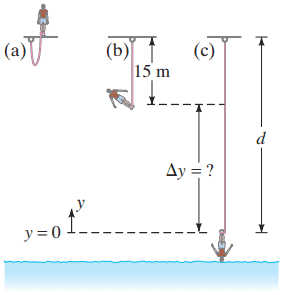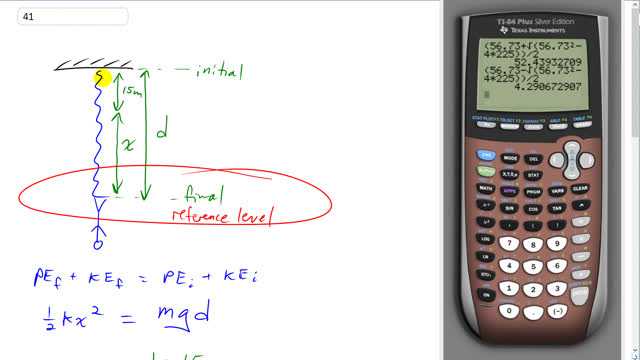
Chris jumps off a bridge with a bungee cord (a heavy stretchable cord) tied around his ankle, Fig. 6–42. He falls for 15 m before the bungee cord begins to stretch. Chris’s mass is 75 kg and we assume the cord obeys Hooke’s law, , with . If we neglect air resistance, estimate what distance below the bridge Chris’s foot will be before coming to a stop. Ignore the mass of the cord (not realistic, however) and treat Chris as a particle.


In order to watch this solution you need to have a subscription.
This is Giancoli Answers with Mr. Dychko. The total energy when the bungee jumper is on the bridge, equals the total energy that they have when they are at the bottom of their fall and the bungee cord is fully stretched. And, at both of these positions, there's no kinetic energy so that makes life a little simpler there. And, at the initial position, they have only gravitational potential because there's no stretching of the bungee cord here when they are up on the bridge. And, when they are at the bottom here, we are gonna take this final position to be the reference level, and so their height will be zero and so there's no gravitational potential here. And there's gonna be only elastic potential energy, one-half k times the amount of stretch of the bungee cord, squared. Now, the bungee cord doesn't start stretching until they have already fallen 15 meters. So we'll take that into account, by saying that this x here, this stretch is the total distance from the bridge to where they end their fall minus 15; so it's gonna be d minus 15 is x. And then we'll substitute that in. In place of x, we'll write d minus 15 there instead. And, we end up with one-half k times d minus 15 squared equals mgd. And our job is to solve for d; the distance below the bridge where they come to a stop. We'll multiply both sides by 2 over k, in this line here. And that brings a 2mgd over k on the right side and then left side is just d minus 15 squared. Square that binomial and we get d squared minus 30d plus 225; and then bring this term to the left side and so it's minus 2mgd over k and all that equals zero. This is a quadratic equation and we can factor out the d from these 2 terms and write minus 30 plus 2mg over k, all times d. And, that's a plus sign because we put brackets around it and there's a minus in front of the brackets so when you distribute the minus sign in, you will end up with minus 30d and minus 2mgd over k. So, we know we have done that correctly. And, let's put in some numbers. So, we have the coefficient of the linear term, which is the fancy way of saying the term that has the variable to the power of 1 is gonna be 30 plus 2 times 75 kilograms times 9.8 over 55 newtons per meter and that gives 56.73 and then we plug all that into our quadratic formula. So, we get 56.73 plus or minus the square root of that squared minus 4 times 225 all over 2. And, we get 52.4 meters as our answer. And, you could have put a minus sign into the quadratic formula and got the answer 4.3. And we know that that is nonsensical because surely they are gonna come to a stop at a position more than 15 meters because they don't even begin stopping; the bungee cord doesn't even begin stretching until they have already fallen 15 meters. So, they are certainly not gonna stop after only 4.3 meters. So, there we go. We come to a stop 52.4 meters below the bridge.
hello :).., i didnt understand why we take the final position as a reference instead of the initial point ..i thought that we always take initial point as a referance
to keep the numbers positive. positive 15 instead of negative 15
3 years late lol
Thank for participating Nabeel! Someone else will come along wondering the same thing, and still see your answer.
All the best,
Mr. Dychko
hello, why there is no kinetic energy?
Hi simone, thank you for your question. There certainly is kinetic energy during the decent, but at the bridge and at the very bottom of the bungee cord stretch there is no kinetic energy: it's all potential energy! Considering only these two positions simplifies the solution since we don't need a term for kinetic energy.
All the best,
Shaun
Where did you get the 225 from?
FOIL the (d-15)^2 to get d^2-30d+225. -15x-15=225